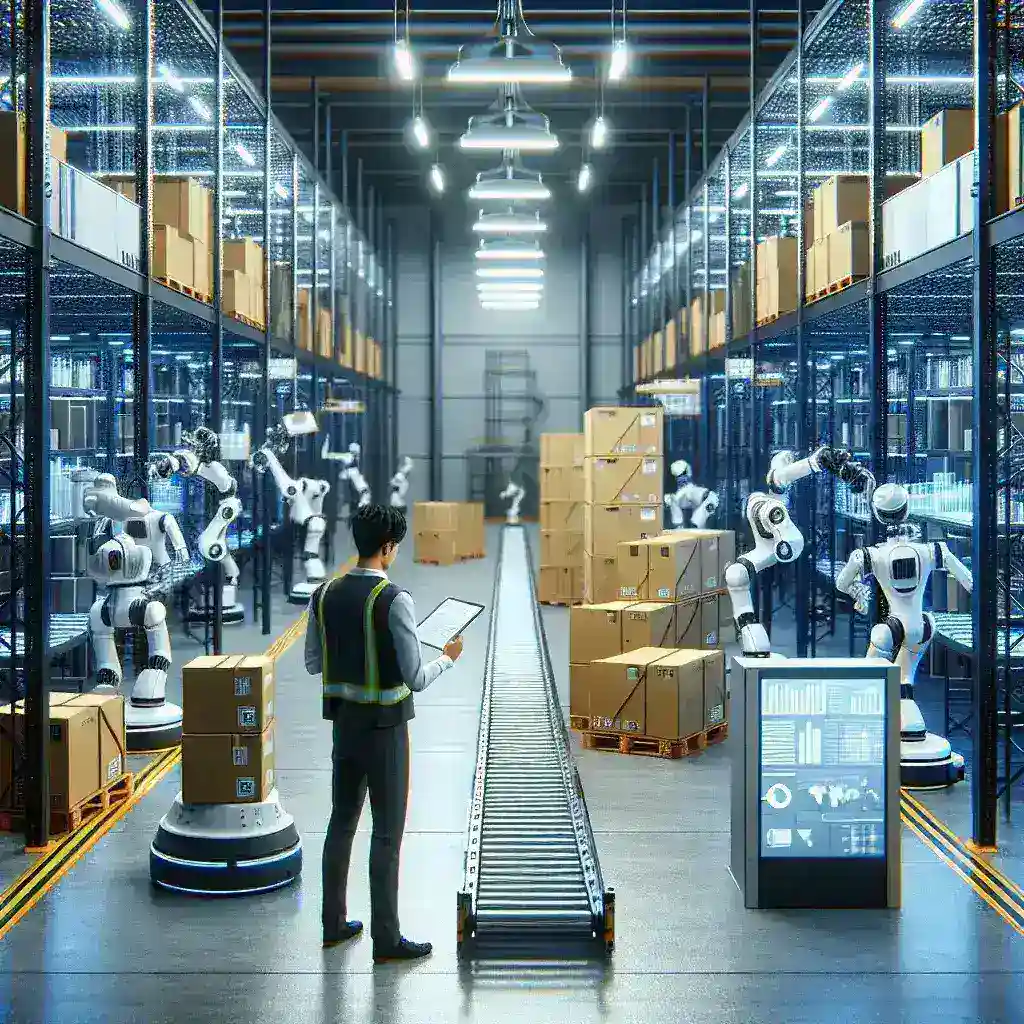The Evolution of Warehouse Operations: From Manual to Robotic Systems
Warehouses have undergone a remarkable transformation over the past few decades. What once relied heavily on manual labor and paper-based systems has evolved into sophisticated operations powered by cutting-edge technology. At the forefront of this revolution are robotic systems that automate warehouse operations, dramatically increasing efficiency and productivity across the supply chain.
The journey from traditional warehousing to today’s automated facilities reflects the broader digital transformation sweeping across industries worldwide. With global e-commerce sales projected to reach $7.4 trillion by 2025, warehouses face unprecedented pressure to process more orders faster than ever before. This demand has catalyzed the adoption of robotic systems as a strategic necessity rather than just an operational upgrade.
Understanding Warehouse Automation and Robotic Systems
Warehouse automation encompasses a range of technologies and systems designed to minimize human intervention in routine tasks. Robotic systems represent the most advanced form of this automation, bringing intelligence, precision, and tireless operation to the warehouse floor.
Key Components of Modern Warehouse Robotic Systems
- Automated Guided Vehicles (AGVs): Self-propelled vehicles that navigate predetermined routes to transport materials throughout the warehouse
- Autonomous Mobile Robots (AMRs): More sophisticated than AGVs, these robots use sensors and AI to navigate dynamically and make decisions
- Robotic Picking Systems: Automated arms and grippers that select items from shelves with precision
- Automated Storage and Retrieval Systems (AS/RS): High-density storage solutions that automatically place and retrieve items
- Sortation Systems: Automated conveyor and diverter systems that route products to their correct destinations
- Packaging Robots: Systems that automate the packaging process, from box assembly to sealing
- Drones: Increasingly used for inventory management and surveillance within large facilities
These components work together within an integrated ecosystem, often orchestrated by sophisticated warehouse management systems (WMS) and artificial intelligence that optimizes their deployment and coordination.
The Business Case for Robotic Warehouse Automation
The adoption of robotic systems in warehouses isn’t merely following a technological trend—it’s a strategic business decision driven by compelling economics and operational benefits.
Economic Benefits of Warehouse Robotics
While the initial investment in robotic systems can be substantial, ranging from hundreds of thousands to millions of dollars depending on the scale and sophistication, the return on investment often justifies the expenditure:
- Labor Cost Reduction: Robots can operate 24/7 without breaks, sick days, or shift changes, potentially reducing labor costs by 50-70% in certain operations
- Space Optimization: Automated systems can operate in narrower aisles and utilize vertical space more effectively, increasing storage capacity by up to 40%
- Error Reduction: Robotic systems achieve accuracy rates of 99.9% or higher, dramatically reducing costly picking errors
- Throughput Increase: Automated facilities can process 2-3 times the volume of traditional warehouses
- Energy Efficiency: Modern robotic systems can reduce energy consumption by operating in low-light conditions and optimizing movement patterns
Industry research suggests that fully automated warehouses can achieve operating cost reductions of 20-40% compared to traditional facilities, with payback periods typically ranging from 2-5 years depending on implementation scale and existing infrastructure.
Operational Excellence Through Automation
Beyond pure cost considerations, robotic systems transform warehouse operations in fundamental ways:
- Scalability: Automated systems can flex to accommodate seasonal peaks without the challenges of temporary staffing
- Consistency: Robots perform tasks with the same precision regardless of time of day or length of operation
- Data Collection: Every movement and action generates data that can be analyzed to further optimize operations
- Safety Improvements: Robots handle dangerous or ergonomically challenging tasks, reducing workplace injuries
- Sustainability: Optimized movements and resource usage reduce the carbon footprint of warehouse operations
Transformative Robotic Technologies in Modern Warehouses
The landscape of warehouse robotics continues to evolve rapidly, with several technologies proving particularly transformative for efficiency and productivity.
Goods-to-Person (GTP) Systems
Traditional warehousing required workers to walk miles daily retrieving items—a profound inefficiency. Goods-to-Person systems invert this paradigm:
- Robotic shuttles retrieve storage units containing needed items
- Items are delivered directly to stationary human pickers at ergonomic workstations
- Productivity increases of 200-300% are common with these systems
- Leading examples include systems from companies like Geek+, Exotec, and AutoStore
One European fashion retailer implemented a GTP system that reduced order fulfillment time from 90 minutes to under 30 minutes while doubling throughput capacity in the same physical footprint.
Autonomous Mobile Robots (AMRs)
Perhaps the most versatile robotic systems in warehouses today, AMRs represent a quantum leap from earlier automation:
- Unlike fixed infrastructure, AMRs can be deployed rapidly with minimal facility modifications
- Machine learning allows AMRs to improve their navigation and task execution over time
- Modern AMRs can work collaboratively alongside humans without safety barriers
- Fleet management systems optimize robot deployment based on real-time priorities
A major pharmaceutical distributor deployed a fleet of 100 AMRs and reported a 50% reduction in labor requirements while improving order accuracy from 99.5% to 99.9%—a seemingly small improvement that translated to thousands fewer errors annually.
Robotic Piece-Picking
Long considered the holy grail of warehouse automation, robotic systems can now reliably pick individual items of varying shapes, sizes, and fragility:
- Advanced vision systems identify optimal grasping points
- Soft robotic grippers handle delicate items without damage
- AI continuously improves picking strategies for new or unusual items
- Pick rates of 600-1,200 items per hour exceed human capabilities
A consumer electronics company implemented robotic piece-picking and saw a 35% reduction in processing costs while extending operating hours without additional labor.
Exoskeletons and Collaborative Robots
Not all robotic systems replace human workers—some enhance their capabilities:
- Powered Exoskeletons: Wearable mechanical devices that augment human strength, allowing workers to lift heavier items with less strain
- Collaborative Robots (Cobots): Robots designed to work alongside humans, taking on repetitive tasks while humans handle more complex decisions
- Follow-Me Systems: Robotic carts that automatically follow workers through the warehouse, eliminating pushing heavy loads
These human-augmenting technologies address both labor shortages and workplace safety, with one study showing a 60% reduction in back injuries after exoskeleton implementation.
Real-World Impact: Case Studies in Warehouse Robotics
The abstract benefits of robotic systems become concrete when examining specific implementations across different industries.
E-commerce Giant’s Fulfillment Revolution
A leading global e-commerce company has deployed over 200,000 robotic systems across its fulfillment network, achieving remarkable results:
- 50% reduction in “click to ship” time
- Storage capacity increased by 40% in the same physical footprint
- Order accuracy improved to 99.99%
- Energy consumption reduced by 20% per package
Their robotic ecosystem includes autonomous mobile robots that transport shelving units, robotic arms for palletizing, and automated packaging systems that create custom-sized boxes for each order.
Third-Party Logistics Provider’s Flexibility Solution
A 3PL company serving multiple clients with varying needs implemented a modular robotic system:
- Scalable robot fleet that expands or contracts based on seasonal demand
- Reconfigurable picking stations that adapt to different product types
- Cloud-based orchestration system that optimizes robot deployment across multiple facilities
This flexibility allowed them to reduce labor costs by 30% while accommodating 25% year-over-year growth without facility expansion.
Grocery Chain’s Micro-Fulfillment Centers
A supermarket chain implemented robotic micro-fulfillment centers attached to existing stores:
- Compact AS/RS systems storing up to 15,000 SKUs in a 10,000 sq ft footprint
- Robotic picking of ambient, chilled, and frozen goods
- Integration with manual picking for ultra-fresh items
These systems reduced online order fulfillment costs by 48% while cutting picking time from 60 minutes to less than 10 minutes per order.
Implementation Challenges and Solutions
Despite compelling benefits, implementing robotic warehouse systems comes with significant challenges that organizations must navigate carefully.
Financial Considerations
The capital expenditure required for robotic systems can be daunting:
- Alternative Financing Models: Robots-as-a-Service (RaaS) options allow companies to pay monthly operational fees rather than large upfront investments
- Phased Implementation: Starting with targeted automation of high-volume processes before expanding
- Hybrid Approaches: Combining limited automation with optimized manual processes
Companies that cannot justify full automation can still benefit from targeted robotic deployments in areas with the highest labor costs or ergonomic challenges.
Technical Integration
Robotic systems must work seamlessly with existing warehouse operations:
- WMS Integration: Ensuring robotic systems communicate effectively with inventory management software
- Physical Infrastructure: Modifying facilities for optimal robot operation, including floor surfaces, lighting, and connectivity
- Data Standards: Establishing protocols for information exchange between different automated systems
Organizations succeeding in this area typically establish cross-functional teams that include IT, operations, and robotics specialists to ensure comprehensive integration.
Workforce Transition
Perhaps the most sensitive aspect of warehouse automation is its impact on human workers:
- Skill Development: Training programs that help workers transition to robot operation and maintenance roles
- Change Management: Clear communication about how automation will affect job roles
- Collaborative Design: Involving frontline workers in automation planning to leverage their operational knowledge
Companies that view automation as augmenting rather than replacing their workforce typically experience smoother implementations and better long-term results.
The Future of Robotic Warehouse Systems
The evolution of warehouse robotics continues at a rapid pace, with several emerging trends shaping the next generation of automation.
AI-Driven Adaptability
Future robotic systems will feature unprecedented adaptability:
- Self-learning algorithms that optimize robot behavior based on changing conditions
- Predictive intelligence that anticipates demand patterns and prepositions inventory
- Adaptive gripping systems that automatically adjust to new product types without reprogramming
These advances will reduce the expertise needed to deploy and maintain robotic systems, making them accessible to smaller operations.
Swarm Robotics
Inspired by natural systems like ant colonies, swarm robotics represents a paradigm shift in warehouse automation:
- Large numbers of relatively simple, inexpensive robots
- Decentralized control that allows the system to function even if individual robots fail
- Emergent intelligence where the collective achieves more than the sum of individual robots
Early implementations have shown remarkable resilience to disruption and ability to scale smoothly from small to massive operations.
Sustainable Automation
Environmental considerations are increasingly influencing robotic system design:
- Energy-harvesting robots that recharge through movement or ambient light
- Automated systems optimized for package consolidation to reduce shipping materials
- Robots designed for disassembly and component recycling at end-of-life
These green innovations align warehouse automation with broader corporate sustainability goals while often reducing operational costs.
Strategic Considerations for Warehouse Automation
Organizations contemplating warehouse robotics must approach the decision strategically rather than tactically.
Automation Readiness Assessment
Before investing in robotics, companies should conduct thorough readiness assessments:
- Process standardization evaluation to ensure operations are consistent enough for automation
- Data quality assessment to confirm that information systems can support robotic operations
- Physical infrastructure review to identify necessary facility modifications
- Workforce skills analysis to understand training and transition requirements
This assessment provides a roadmap for preparation steps that should precede robot deployment.
Build vs. Partner Decisions
Organizations have multiple paths to warehouse automation:
- In-house Development: Building proprietary automation solutions tailored to specific needs
- System Integrator Partnerships: Working with specialists who configure commercial robots for specific applications
- Third-Party Logistics: Outsourcing to 3PLs that have already invested in robotic infrastructure
The optimal approach depends on the strategic importance of fulfillment operations and available internal expertise.
Measuring Automation Success
Effective measurement frameworks are essential for evaluating robotic implementations:
- Multi-dimensional metrics that consider speed, accuracy, cost, and flexibility
- Pre/post implementation benchmarking to quantify improvements
- Ongoing performance monitoring to identify optimization opportunities
Organizations should resist focusing solely on labor reduction and instead measure the comprehensive impact on customer satisfaction and market competitiveness.
Conclusion: The Strategic Imperative of Warehouse Robotics
Robotic systems that automate warehouse operations represent more than an efficiency improvement—they constitute a strategic transformation of how products move from manufacturers to consumers. As e-commerce continues to grow and consumer expectations for delivery speed intensify, conventional warehousing approaches face insurmountable scaling challenges.
The organizations that thrive in this environment will be those that view robotic automation not merely as a cost-reduction tactic but as a core capability that enables business model innovation and customer experience differentiation. The most successful implementations will balance technological sophistication with human expertise, creating systems where robots handle routine tasks while people focus on exception management and customer-centric innovation.
The warehouse of the future will not be distinguished by the absence of humans, but by humans and robots working in concert, each contributing their unique strengths to create operations that are simultaneously more efficient, more responsive, and more sustainable than what either could achieve alone.
As robotic systems continue to evolve in capabilities while becoming more accessible in cost, the question for most organizations is not whether to automate their warehouse operations, but how quickly and comprehensively they can implement automation while maintaining operational continuity and workforce engagement. Those who answer this question effectively will position themselves for success in an increasingly competitive and fast-paced distribution landscape.





